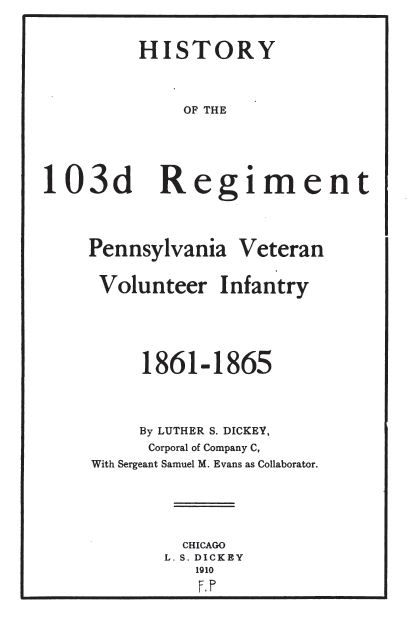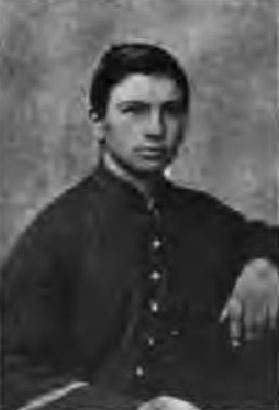History of the 103rd Pennsylvania Infantry
Posted By Norman Gasbarro on September 8, 2012
History of the 103d Regiment Pennsylvania Veteran Volunteer Infantry [103rd Pennsylvania Infantry], by Luther S. Dickey, was published in 1910 by L. S. Dickey in Chicago. Dickey was a Corporal in the regiment and Sgt. Samuel M. Evans served as collaborator for the work.
The book has been digitized by Google and is available as a free download. Click here and then follow the instructions in the red box (EBOOK-FREE) at the left side of the page. The book is available to download in several formats.
At the end of the Civil War, men from the Lykens Valley area were recruited to serve in this regiment and were assigned to replacement companies. Their experiences were quite different than those men who served in the regiment from its inception and organization, which took place from August 1861, to February 1862. The book mainly tells the history of the regiment from the Battle of Williamsburg, Virginia, 4 May 1862 to 7 May 1862 through the eventual loss at the Battle of Plymouth, North Carolina, 17 April 1864 to 20 April 1864 and the subsequent capture and imprisonment of nearly all the men, most sent as far away as Andersonville, Georgia.
The book is filled with photographs of many of the men who served in the regiment, although most of these pictures are only of fair quality. There are personal reminiscences (called “sketches”), stories of a prison escape, and detailed descriptions of two battles (the Battle of Seven Pines and the Battle of Plymouth). For the battle descriptions, Dickey relies heavily on first-hand military reports as well as some non-official reminiscences. There are also two diaries, one of which is by an author unknown, and the other by Major Mackey, which records his 10 months of life in Confederate prisons. All-in-all, the book is rich in primary source material and as a regimental history, is very comprehensive. One of the concluding chapters describes the 31st Annual Reunion of the regiment.
For the men of the new companies of the 103rd Pennsylvania Infantry who were sent to North Carolina in March 1865, there is little that would be recognized in this volume, but their service is not neglected in the history. It is important to recognize that this regiment, to which the new men were assigned, had a very difficult time following its capture at Plymouth, and the tremendous losses in life and to the health of the men as a result of their imprisonment played heavily on the survivors as they filtered back to North Carolina to re-join the regiment as they were released from Andersonville. Thus, the conditions at Roanoke Island (where the remnants of the regiment were stationed), until discharge of the 103rd in June 1865, were affected by this curious mix of recently-released survivors of more than three years of battle (including nearly a year of imprisonment) and new recruits who were charged with keeping military discipline among those who wished to celebrate their freedom and return to their homes as quickly as possible.
To his credit, Dickey does not ignore this last period in the history of the regiment. The men who served in the replacement companies are included in the rosters that appear at the end of the book.
After the Battle of Plymouth, the entire captured regiment was moved to Confederate prisons. In the post tomorrow, Dickey’s description of the journey to Andersonville, Georgia, will be presented. In the post on Tuesday, Dickey’s comments on the final days of the regiment will be given along with the roster of the 2nd Company G of the 103rd Pennsylvania Infantry, the replacement company consisting mostly of men from the Lykens Valley area.
 ;
;




My great Grandfather served in the 103rd Pennsylvania Regiment and survived Andersonville Prison. His name was Clarence Gelston. God Bless all who served.